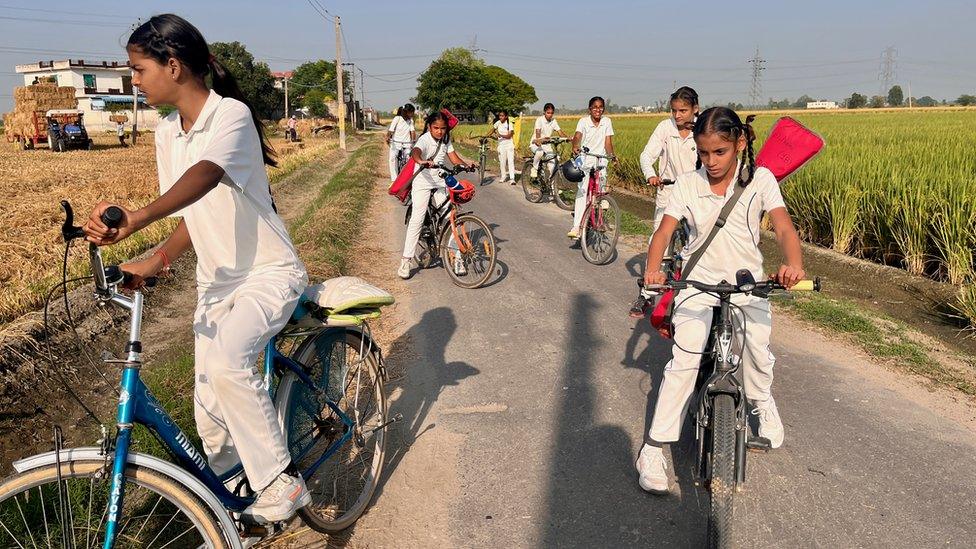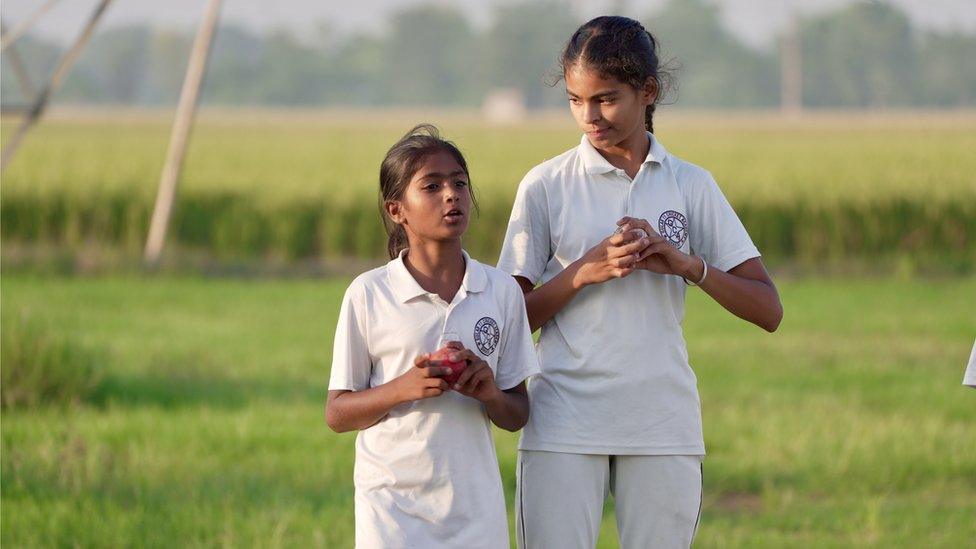An all girls cricket team in India breaks with tradition
- Published

Gulab Singh Shergill believes girls in his village deserve a shot at chasing their dreams
More than a dozen young girls from a small village cycle through farmland in the Indian state of Punjab.
Moving along a dirt pathway, dressed all in white, their excitement starts to build. Amid the miles of wheat fields, emerges the source of their joy: two cricket pitches, with plastic wickets and strip of concrete from where they can bat.
If it conjures images of the 1989 Hollywood film, Field of Dreams, external, it wouldn't be too far from the truth. These 18 girls make up the Gulab Singh Cricket Team.
Cricket is the most popular sport in India, akin to a religion many would say. While it continues to remain a male-dominated game, things are changing.
Earlier this year, India started a women's cricket premier league (WPL), a female version of the Indian Premier League (IPL). It has quickly become one of the world's most lucrative women's franchises, second only to the Women's National Basketball Associate in the US.
Women in India have been active - and high performing - in cricket for many years. The WPL has catapulted them into mainstream popularity. Now they get the kind of media attention only reserved for men's teams.
In October, the Board of Control for Cricket in India (BCCI), the governing body of Indian cricket, said all contracted female cricketers would be paid the the same match fee as men - a historic decision to promote "gender equality" in the country's most-loved game.
Despite the changes on the national level, it can still be difficult for girls to be afforded the opportunity to play, especially in rural towns.
"I created this cricket team to make their lives better," says Gulab Singh Shergill, 35, who started this plucky little league four years ago.

Gulab Singh Shergill started the little league four years ago
Partly to live out his failed dreams of playing cricket professionally and mostly because he really believes the girls in the village deserve a shot.
"They don't get permission to get a higher education, only getting to tenth class," he says. After that, it's a life of cooking and cleaning until they are married and sent to live with their in-laws.
His players are being exposed to something different. Every day, they come here, park their bikes under a tree behind the batting area and head to the grassy field where they start warming up.
Simranjit Kaur, 13, is learning to bowl. She runs down the pitch, rotates her arm and lets the leather ball out of her hand. Her height allows her to get speed and she says her accuracy is starting to improve.
She is quiet and soft spoken, still very much the frame of a child but has had to grow up fast. After her mother died suddenly three years ago, her grandmother has become her primary caretaker, along with her two younger sisters, aged 10 and three.
She joined the team a few years ago after seeing them play in a tournament in a neighbouring village with her father, a cricket enthusiast.
"My father asked me if I would like to play," she said in the courtyard of her house. "I said yes. So he asked the coach if I could join. And he said to come the next day."

Simranjit Kaur, right, is learning to bowl
In the morning before going to school, Simranjit crouches by a stove next to her grandmother, making rotis for the family. After school, instead of being stuck inside like many girls her age, with the support of her father and grandmother, she throws on her cricket whites and heads to practice, her sister in tow.
"There's an ill thinking in villages," says Baljeet Kaur, Simran's grandmother. "They say that girls should be married and sent off to her in-laws, as if they have got no life. Sometimes people in village tell us why are you sending girls for playing. This is our wish and we want them to play."
When asked how she feels when people discourage her, Simranjit says, "I [don't] want to stop playing, this is my life. I feel really bad because I really like cricket, I really like playing."
Cricket is not Shergill's full-time job; he works as a constable in the local police force.
The players pay for nothing, he says. His entire salary goes to the girls' team: paying for a part time coach, getting uniforms and equipment. He has donated a part of his land for the cricket pitch and hopes to one day build an office with a toilet.
It's only been four years but in that time he's been able to expose these girls to a life beyond the bounds of their village.
"Now we are also able to have matches between girls and boys," he says. "That makes them proud of themselves. Now they are able to tell their parents that 'I can do it.'"
For these girls, playing cricket is a break from the societal duties that come with being a girl. For a few hours a day, the shed gender norms and are able to be kids.
"When we are playing a match, I feel like I am wearing a jersey for Team India," says 10-year-old Harsimrit Kaur.
"When I hit a six, I know I did it for India. When I play I feel only one thing, that I am not playing for India now but I will play for India's cricket team someday."

Harsimrat Kaur, 10, says playing a match feels like 'I am wearing a jersey for Team India'
Shergill has the support of strong women too. His eldest sister, Jasveer Kaur, affectionately called Bua, is one of Shergill's biggest champions.
She comes to the pitch at least once a week to comfort players that get hurt or just to watch. She knows too well the pressures of being a woman in this society.
Married at 19, becoming a mother shortly thereafter, Jasveer cries at the thought of any of these girls meeting the same fate.
"All my feeling and hopes were suppressed because I was a woman," she says. "I was asked to work at home and cook also. Now I want that if I can help girls to do something I don't need anything else in life. I want to use all my power to help girls grow."
Shergill may be selling a dream to become a professional cricket player and represent India around the world. But the lessons he is teaching the these young women is so much more valuable.
"There is no difference between a girl and a boy," says Simranjit. "Whatever boys can do, girls can do too."
Photos by Aamir Peerzada
BBC News India is now on YouTube. Click here, external to subscribe and watch our documentaries, explainers and features.

Read more India stories from the BBC:
